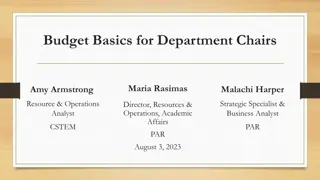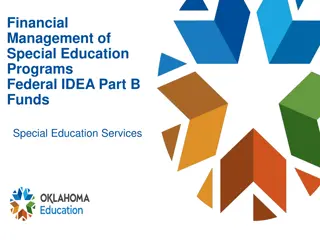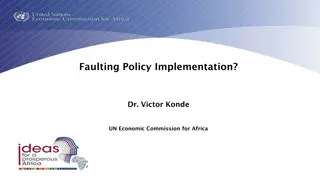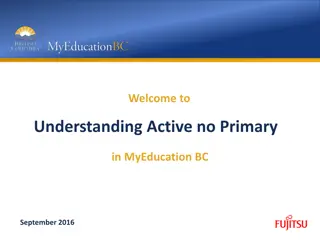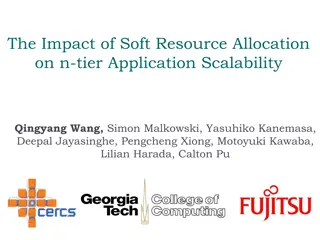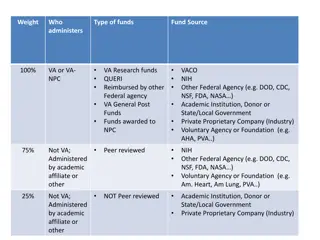Implementation of Public Policy Concerning Physical Special Allocation Funds in Education at Primary School Level in Bandung Education Sector
Educational facilities in primary schools in Bandung are facing challenges in implementing physical special allocation funds effectively. Issues include inconsistencies in fund usage, lack of understanding among principals, and insufficient national funds. The study explores these challenges through a literature review, methodology involving qualitative research, and discussions on the involvement of school principals in technical guidance sessions.
Download Presentation

Please find below an Image/Link to download the presentation.
The content on the website is provided AS IS for your information and personal use only. It may not be sold, licensed, or shared on other websites without obtaining consent from the author. Download presentation by click this link. If you encounter any issues during the download, it is possible that the publisher has removed the file from their server.
E N D
Presentation Transcript
THE IMPLEMENTATION OF PUBLIC POLICY CONCERNING PHYSICAL SPECIAL ALLOCATION FUNDS IN EDUCATION AT PRIMARY SCHOOL LEVEL IN BANDUNG EDUCATION SECTOR The 4th ICREAM, October 21st 2020 Sri Wulansari Indonesia University of Education
1 INTRODUCTION
INTRODUCTION The need for educational facilities in primary schools is increasing. Not all the implementation of physical special allocation fund was carried out independently (swakelola). Several principals proposed physical building fund or learning support equipment which were not listed in the physical DAK operational manual for education. The technical guidelines for DAK was changed frequently and was not concerned to regional needs due to a lack of mapping, understanding of regional specificities and needs. Principal did not understand how to report the use of physical DAK in education sector. The national DAK was relatively small compared to the expected needs and impacts.
2 LITERATURE
LITERATURE REVIEW There are three indicators used to measure the success of communication variables, includes: transmission, clarity, and consistency. The Implementation of George C. Edward III Model The indicators of resources, includes: staff, information, authority, facility. The complex policies require the cooperation of many people. When the bureaucratic structure is not conducive to the available policies, thus, it impacts ineffective and unmotivated resources. Consequently, it hinders the policies implementation. The importance aspects at disposition variable, includes: disposition effect, conducting bureaucratic arrangements, incentives.
3 METHODS
METHOD The qualitative method was performed. A total of 10 informants include the Head of primary school division, the Head of the primary School Facilities and Infrastructure division, four school principals, and four treasurers was participated. The location was at the Bandung Regency Education Office, located at Jalan Raya Soreang KM 17, Soreang, Bandung Regency, West Java Province. Data was collected in the natural settings of primary data sources. Additionally, the data collection techniques were mainly gathered from participant observation, in-depth interviews, and documentation.
4 DISCUSSION
DISCUSSION 1. The primary school principals have participated the technical guidance held at the Bandung Sector Education Office. The technical guidance invited speakers from various related agencies, such as from the Police, prosecutors, inspectorates, and associated agencies in the Bandung Regency government. The technical guidance expected the school principal to implement the physical DAK program efficiently. 2. The number and quality of officer of Education office is sufficient. 3. The implementers attitude on physical DAK policy in education was quite good. 4. Overall, the implementation of the DAK policy in primary school level has undergone through the process of planning, preparation, implementation, monitoring and evaluation.
5 CONCLUSION
CONCLUSION 1. The educational stakeholder's understanding of the physical Special Allocation Fund (DAK) in the education sector regarding the DAK Operational Guidelines (Petunjuk Operasional DAK Fisik Permendikbud Nomor 11 Tahun 2020) was not maximized. 2. The educational stakeholders understanding in the implementation of physical work was still not in accordance with implementation report based on DAK operational guidelines (Petunjuk Operasional DAK Fisik Permendikbud Nomor 11 Tahun 2020).



